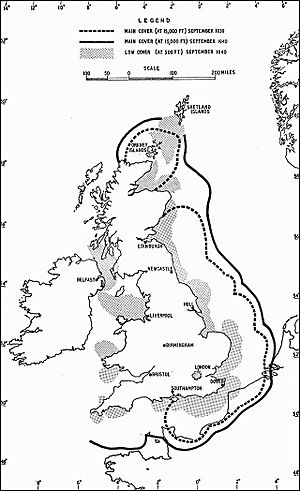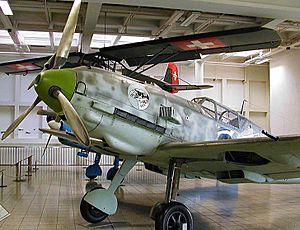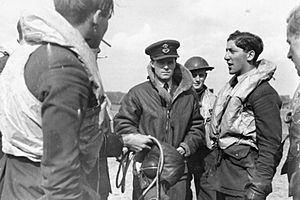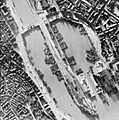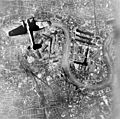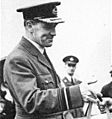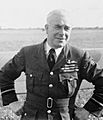Battle of Britain facts for kids
Quick facts for kids Battle of Britain |
|||||||
|---|---|---|---|---|---|---|---|
| Part of the Second World War | |||||||
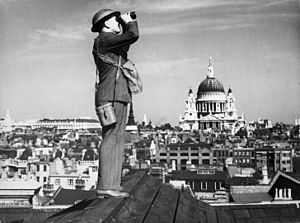 An Observer Corps spotter scans the skies of London. |
|||||||
|
|||||||
| Belligerents | |||||||
| Commanders and leaders | |||||||
| Strength | |||||||
| 1,963 serviceable aircraft | 2,550 serviceable aircraft. | ||||||
| Casualties and losses | |||||||
| 544 aircrew killed 422 aircrew wounded 1,547 aircraft destroyed |
2,698 aircrew killed 967 captured 638 missing bodies identified by British Authorities 1,887 aircraft destroyed |
||||||
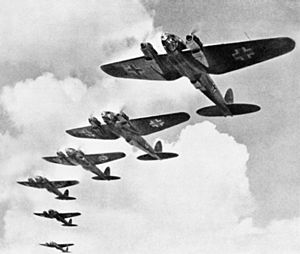
The Battle of Britain was a continued attack by the German Air Force (Luftwaffe) on Great Britain during the Summer and Autumn of 1940.
Contents
Overview
Its first objective was to gain control of the air space above Britain from the Royal Air Force (RAF), especially the Fighter Command.
The name comes from a famous speech delivered by Prime Minister Winston Churchill in the House of Commons: "The Battle of France is over. I expect the Battle of Britain is about to begin..."
The Battle of Britain was the first major campaign to be fought only by air forces and was also the largest and longest aerial bombing campaign to that date.
Part I: Strategic targets
From July 1940 coastal shipping convoys and shipping centres, such as Portsmouth, were the main targets. A month later the Luftwaffe shifted its attacks to RAF airfields and infrastructure (other useful war targets). As the battle progressed the Luftwaffe also targeted aircraft factories and ground infrastructure.
Coastal radar stations were bombed, so that at one point only one radar mast was standing. The British used a back-up system of human observers to get information to the headquarters of Fighter Command. Most historians agree this part of the campaign went in Germany's favour.
Part II: Civilian targets
Eventually the Luftwaffe switched to attacking population centres, such as towns and cities, as well as factories. After the RAF bombed Berlin, and German air force bases in France, Adolf Hitler cancelled his orders not to bomb population centres and ordered attacks on British cities.p305 The attacks on civilians were terror bombing tactics designed to cause panic and damage morale.
On the 7th of September 1940, a massive series of raids with nearly four hundred bombers and more than six hundred fighters targeted docks on the Thames in London, day and night.
The RAF 11 Group rose to meet them, in greater numbers than the Luftwaffe expected. 12 Group's Big Wing took twenty minutes to gain formation, missing its intended target, but coming across another formation of bombers while still climbing. They returned, feeling sorry about their limited success, and blamed the delay on being requested too late.
The Luftwaffe began to abandon their morning raids, with attacks on London starting late in the afternoon for 57 nights of attacks in a row.
Fighter Command had been suffering low morale, short of men and machines, and the break from airfield attacks allowed them to recover. This meant that week by week, the defenders were getting stronger, and the losses suffered by the Lutfwaffe were growing.
On 15 September two massive waves of German attacks were prevented by the RAF, with every aircraft of 11 Group being used on that day. The total casualties on this important day were 60 German and 26 RAF aircraft shot down. The German defeat caused Hitler to order, two days later, the "postponement" of preparations for the invasion of Britain. Afterwards, in the face of increasing losses in men, aircraft and the lack of good replacements, the Luftwaffe switched from daylight to night-time bombing.
On 27 September, a Junkers Ju 88 returning from a raid on London was shot down in Kent. The German airmen survived to fight a battle against British troops stationed locally. It is said to be the first time in nearly 300 years that armed invaders had fought with British soldiers on British soil.
The Dowding system
The keystone of the British defence was the detection, command, and control which ran the battle. This was the 'Dowding System', after its chief architect, Air Chief Marshal Sir Hugh Dowding, the leader of RAF Fighter Command.
The core of Dowding's system was the use of Radio Direction Finding (RDF, later called radar, for radio detection and ranging). Its use, plus by information by the Royal Observer Corps, was crucial. It allowed the RAF to intercept incoming German aircraft. Radar operators were linked via telephone (whose wires were laid deep underground with concrete anti-bomb protection) to an operational centre. This centre was Fighter Command control at Bentley Priory. During the Battle several Coastal Command and Fleet Air Arm units came under Fighter Command control.
Fighters
The Luftwaffe's Messerschmitt Bf 109E and 110C squared up against the RAF's workhorse Hawker Hurricane Mk I and the less numerous Supermarine Spitfire Mk I. The Bf 109E had a better climb rate and was 10 to 30 mph faster than the Hurricane, depending on altitude. In September 1940 the more powerful Mk IIa series 1 Hurricane started entering service although only in small numbers. This version was capable of a maximum speed of 342 mph, some 25 to 30 mph faster than the Mk I.
The performance of the Spitfire over Dunkirk came as a surprise, although the German pilots retained a strong belief that the 109 was the superior fighter. However, the Bf 109E had a much larger turning circle than either the Hurricane or the Spitfire. The two British fighters had eight Browning 303 machine guns, while most Bf 109Es had two machine guns and two wing cannons. The Bf 109E and the Spitfire were superior to each other in key areas; for instance, at some altitudes, the Bf 109 could out-climb the British fighter.
Consequences
The failure of Nazi Germany to achieve its objectives of destroying Britain's air defences, or forcing Britain to negotiate an armistice or an outright surrender, is considered its first major defeat and one of the crucial turning points in the war.
If Germany had gained air superiority, Adolf Hitler might have launched Operation Sea Lion, a planned amphibious and airborne invasion of Britain.
Interesting facts about the Battle of Britian
- It was the worlds first battle to be waged largely in the air.
- The Battle of Britain was a huge turning point in World War II. Since Britain was able to stop the Luftwaffe destroying their air defences it stopped Hitler's plan of invading Britain.
- 14,286 civilians were killed during the Battle of Britain.
- Hitler initially thought Britain would surrender without a fight.
- The Germans lost 1,733 aircraft and 3,893 men in the Battle of Britain.
- The Polish pilots of the 303 Squadron were the most successful fighters in the sky shooting down 126 German planes in 42 days.
Images for kids
-
Hawker Hurricane R4118 fought in the Battle of Britain. Here it arrives at the 2014 Royal International Air Tattoo, England.
-
X4382, a late production Spitfire Mk I of 602 Squadron flown by P/O Osgood Hanbury, Westhampnett, September 1940
-
South African Adolph "Sailor" Malan led No. 74 Squadron RAF and was, at the time, the RAF's leading ace, with 27 planes destroyed, 7 shared, 2 unconfirmed, 3 probables and 16 damaged.
-
Hermann Göring, the commander of the Luftwaffe
-
Hugo Sperrle, the commander of Luftflotte 3
-
Pattern of vapour trails left by British and German aircraft after a dogfight
-
Adolf Galland, the successful leader of III./JG 26, became Geschwaderkommodore of JG 26 on 22 August.
-
X4474, a late production Mk I Spitfire of 19 Squadron, September 1940. During the battle 19 Squadron was part of the Duxford Wing.
-
Douglas Bader commanded 242 Squadron during the battle. He also led the Duxford Wing.
-
A Bristol Blenheim Mk IV of 21 Squadron
-
German invasion barges waiting at Boulogne Harbour, France during the Battle of Britain
-
Interior of RAF Fighter Command's Sector 'G' Operations Room at Duxford, 1940
-
East Coast Chain Home radar station
-
Czechoslovak fighter pilots of No. 310 Squadron RAF at RAF Duxford in 1940
-
Pilots of No. 19 Squadron RAF relax in the crew room at RAF Fowlmere, 1940
-
Polish 303 Squadron pilots, 1940. Left to right: P/O Ferić, Flt Lt Kent, F/O Grzeszczak, P/O Radomski, P/O Zumbach, P/O Łokuciewski, F/O Henneberg, Sgt. Rogowski, Sgt. Szaposznikow.
-
Pilots of No. 66 Squadron at Gravesend, September 1940
-
Heinkel He 111 bomber over the Surrey Commercial Docks in South London and Wapping and the Isle of Dogs in the East End of London on 7 September 1940
-
Air-raid shelter in London, 1940
-
A Dornier falling on Victoria Station after being rammed by Ray Holmes, 15 September 1940
-
Gun camera film shows tracer ammunition from a Supermarine Spitfire Mark I of 609 Squadron, flown by Flight Lieutenant J H G McArthur, hitting a Heinkel He 111 on its starboard quarter. These aircraft were part of a large formation from KG 53 and 55 which attacked the Bristol Aeroplane Company's works at Filton, Bristol, just before midday on 25 September 1940.
-
Commander-in-Chief, Air Chief Marshal Sir Hugh Dowding
-
10 Group Commander, Sir Quintin Brand
-
11 Group Commander, Keith Park
-
12 Group Commander, Trafford Leigh-Mallory
-
13 Group Commander, Richard Saul
See also
 In Spanish: Batalla de Inglaterra para niños
In Spanish: Batalla de Inglaterra para niños



